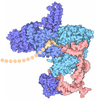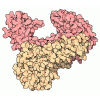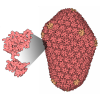[English] 日本語
 Yorodumi
Yorodumi- PDB-9mxb: Crystal Structure of WT HIV-1 Reverse Transcriptase in Complex wi... -
+ Open data
Open data
- Basic information
Basic information
| Entry | Database: PDB / ID: 9mxb | |||||||||
|---|---|---|---|---|---|---|---|---|---|---|
| Title | Crystal Structure of WT HIV-1 Reverse Transcriptase in Complex with 5-{2-[2-(2-oxo-4-sulfanylidene-3,4-dihydropyrimidin-1(2H)-yl)ethoxy] phenoxy}naphthalene-2-carbonitrile (JLJ648), a non-nucleoside inhibitor | |||||||||
 Components Components |
| |||||||||
 Keywords Keywords | VIRAL PROTEIN / REVERSE TRANSCRIPTASE / ANTIVIRAL / DRUG DESIGN / HIV-1 | |||||||||
| Function / homology |  Function and homology information Function and homology informationHIV-1 retropepsin / symbiont-mediated activation of host apoptosis / retroviral ribonuclease H / exoribonuclease H / exoribonuclease H activity / host multivesicular body / DNA integration / viral genome integration into host DNA / RNA-directed DNA polymerase / establishment of integrated proviral latency ...HIV-1 retropepsin / symbiont-mediated activation of host apoptosis / retroviral ribonuclease H / exoribonuclease H / exoribonuclease H activity / host multivesicular body / DNA integration / viral genome integration into host DNA / RNA-directed DNA polymerase / establishment of integrated proviral latency / viral penetration into host nucleus / RNA stem-loop binding / RNA-directed DNA polymerase activity / RNA-DNA hybrid ribonuclease activity / Transferases; Transferring phosphorus-containing groups; Nucleotidyltransferases / host cell / viral nucleocapsid / DNA recombination / DNA-directed DNA polymerase / aspartic-type endopeptidase activity / Hydrolases; Acting on ester bonds / DNA-directed DNA polymerase activity / symbiont-mediated suppression of host gene expression / viral translational frameshifting / lipid binding / symbiont entry into host cell / host cell nucleus / host cell plasma membrane / virion membrane / structural molecule activity / proteolysis / DNA binding / zinc ion binding / membrane Similarity search - Function | |||||||||
| Biological species |  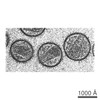 Human immunodeficiency virus 1 Human immunodeficiency virus 1 | |||||||||
| Method |  X-RAY DIFFRACTION / X-RAY DIFFRACTION /  SYNCHROTRON / SYNCHROTRON /  MOLECULAR REPLACEMENT / Resolution: 2.37 Å MOLECULAR REPLACEMENT / Resolution: 2.37 Å | |||||||||
 Authors Authors | Hollander, K. / Jorgensen, W.L. / Anderson, K.S. | |||||||||
| Funding support |  United States, 2items United States, 2items
| |||||||||
 Citation Citation |  Journal: NPJ Drug Discov / Year: 2025 Journal: NPJ Drug Discov / Year: 2025Title: Mechanistic basis for a novel dual-function Gag-Pol dimerizer potentiating CARD8 inflammasome activation and clearance of HIV-infected cells. Authors: Klarissa Hollander / Swapnil C Devarkar / Su Tang / Ritudhwaj Tiwari / Shumeng Ma / Won Gil Lee / Elizabeth Denn / Qiankun Wang / Krasimir A Spasov / Jake A Robbins / Kathleen M Frey / ...Authors: Klarissa Hollander / Swapnil C Devarkar / Su Tang / Ritudhwaj Tiwari / Shumeng Ma / Won Gil Lee / Elizabeth Denn / Qiankun Wang / Krasimir A Spasov / Jake A Robbins / Kathleen M Frey / William L Jorgensen / Yong Xiong / Liang Shan / Karen S Anderson /  Abstract: A strategy to functionally cure AIDS by eliminating latent HIV-1 reservoirs involves non-nucleoside reverse transcriptase inhibitors (NNRTIs) that promote pyroptosis of HIV-1 infected cells. These ...A strategy to functionally cure AIDS by eliminating latent HIV-1 reservoirs involves non-nucleoside reverse transcriptase inhibitors (NNRTIs) that promote pyroptosis of HIV-1 infected cells. These NNRTIs stimulate dimerization of the Gag-Pol polyprotein, resulting in premature HIV-1 protease (PR) dimerization and cleavage of intracellular CARD8. A unique cell-based high-throughput screen was developed to identify potent compounds activating the CARD8 inflammasome through Gag-Pol dimerization. Our in-house library of NNRTIs was evaluated, including a series of catechol diethers, which are potent, nontoxic antivirals. JLJ648 was identified as a promising dual-function antiviral and Gag-Pol dimerizer. Cryo-EM studies of HIV reverse transcriptase p66 bound to JLJ648 revealed populations of homodimers and, surprisingly, a homotetramer. This novel homotetramer structure resembling an 'infinity knot' revealed two JLJ648-bound homodimers forming an extensive interface and nucleated around a dimer of JLJ648 molecules. Structure-guided mutagenesis studies indicate that Gag-Pol homotetramerization may play a critical role in facilitating PR self-cleavage and triggering pyroptosis. | |||||||||
| History |
|
- Structure visualization
Structure visualization
| Structure viewer | Molecule:  Molmil Molmil Jmol/JSmol Jmol/JSmol |
|---|
- Downloads & links
Downloads & links
- Download
Download
| PDBx/mmCIF format |  9mxb.cif.gz 9mxb.cif.gz | 207.9 KB | Display |  PDBx/mmCIF format PDBx/mmCIF format |
|---|---|---|---|---|
| PDB format |  pdb9mxb.ent.gz pdb9mxb.ent.gz | Display |  PDB format PDB format | |
| PDBx/mmJSON format |  9mxb.json.gz 9mxb.json.gz | Tree view |  PDBx/mmJSON format PDBx/mmJSON format | |
| Others |  Other downloads Other downloads |
-Validation report
| Summary document |  9mxb_validation.pdf.gz 9mxb_validation.pdf.gz | 778.2 KB | Display |  wwPDB validaton report wwPDB validaton report |
|---|---|---|---|---|
| Full document |  9mxb_full_validation.pdf.gz 9mxb_full_validation.pdf.gz | 792.7 KB | Display | |
| Data in XML |  9mxb_validation.xml.gz 9mxb_validation.xml.gz | 39.2 KB | Display | |
| Data in CIF |  9mxb_validation.cif.gz 9mxb_validation.cif.gz | 50.2 KB | Display | |
| Arichive directory |  https://data.pdbj.org/pub/pdb/validation_reports/mx/9mxb https://data.pdbj.org/pub/pdb/validation_reports/mx/9mxb ftp://data.pdbj.org/pub/pdb/validation_reports/mx/9mxb ftp://data.pdbj.org/pub/pdb/validation_reports/mx/9mxb | HTTPS FTP |
-Related structure data
| Related structure data |  9mxqC  9mxrC  9mxsC  9mxtC C: citing same article ( |
|---|---|
| Similar structure data | Similarity search - Function & homology  F&H Search F&H Search |
- Links
Links
- Assembly
Assembly
| Deposited unit | 
| ||||||||
|---|---|---|---|---|---|---|---|---|---|
| 1 |
| ||||||||
| Unit cell |
|
- Components
Components
-Protein , 2 types, 2 molecules AB
| #1: Protein | Mass: 63989.238 Da / Num. of mol.: 1 Source method: isolated from a genetically manipulated source Source: (gene. exp.)   Human immunodeficiency virus 1 / Production host: Human immunodeficiency virus 1 / Production host:  References: UniProt: P03366, RNA-directed DNA polymerase, DNA-directed DNA polymerase, retroviral ribonuclease H |
|---|---|
| #2: Protein | Mass: 50119.465 Da / Num. of mol.: 1 Source method: isolated from a genetically manipulated source Source: (gene. exp.)   Human immunodeficiency virus 1 / Gene: gag-pol / Production host: Human immunodeficiency virus 1 / Gene: gag-pol / Production host:  |
-Non-polymers , 4 types, 27 molecules 
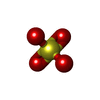
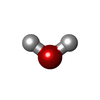


| #3: Chemical | | #4: Chemical | #5: Chemical | ChemComp-A1BTU / | Mass: 415.464 Da / Num. of mol.: 1 / Source method: obtained synthetically / Formula: C23H17N3O3S / Feature type: SUBJECT OF INVESTIGATION #6: Water | ChemComp-HOH / | |
|---|
-Details
| Has ligand of interest | Y |
|---|---|
| Has protein modification | Y |
-Experimental details
-Experiment
| Experiment | Method:  X-RAY DIFFRACTION / Number of used crystals: 1 X-RAY DIFFRACTION / Number of used crystals: 1 |
|---|
- Sample preparation
Sample preparation
| Crystal | Density Matthews: 3.44 Å3/Da / Density % sol: 64.29 % |
|---|---|
| Crystal grow | Temperature: 277 K / Method: vapor diffusion, hanging drop / pH: 5.5 Details: 50 mM Citric Acid pH 5.5, 15% PEG 8000, 100 mM ammonium sulfate, 15 mM magnesium sulfate, and 5 mM spermine PH range: 5.0-7.5 |
-Data collection
| Diffraction | Mean temperature: 100 K / Serial crystal experiment: N |
|---|---|
| Diffraction source | Source:  SYNCHROTRON / Site: SYNCHROTRON / Site:  NSLS-II NSLS-II  / Beamline: 17-ID-2 / Wavelength: 0.979338 Å / Beamline: 17-ID-2 / Wavelength: 0.979338 Å |
| Detector | Type: DECTRIS EIGER X 9M / Detector: PIXEL / Date: Oct 25, 2023 |
| Radiation | Protocol: SINGLE WAVELENGTH / Monochromatic (M) / Laue (L): M / Scattering type: x-ray |
| Radiation wavelength | Wavelength: 0.979338 Å / Relative weight: 1 |
| Reflection | Resolution: 2.37→33.63 Å / Num. obs: 63659 / % possible obs: 100 % / Redundancy: 7 % / CC1/2: 0.999 / Rmerge(I) obs: 0.064 / Rpim(I) all: 0.026 / Rrim(I) all: 0.069 / Χ2: 0.91 / Net I/σ(I): 13.9 / Num. measured all: 446532 |
| Reflection shell | Resolution: 2.37→2.49 Å / % possible obs: 100 % / Redundancy: 7.2 % / Rmerge(I) obs: 2.588 / Num. measured all: 66879 / Num. unique obs: 9286 / CC1/2: 0.493 / Rpim(I) all: 1.026 / Rrim(I) all: 2.786 / Χ2: 0.83 / Net I/σ(I) obs: 0.8 |
- Processing
Processing
| Software |
| |||||||||||||||||||||||||||||||||||||||||||||||||||||||||||||||||||||||||||||||||||||||||||||||||||||||||||||||||||||||||||||||||||||||||||||||||||||||||||||||||
|---|---|---|---|---|---|---|---|---|---|---|---|---|---|---|---|---|---|---|---|---|---|---|---|---|---|---|---|---|---|---|---|---|---|---|---|---|---|---|---|---|---|---|---|---|---|---|---|---|---|---|---|---|---|---|---|---|---|---|---|---|---|---|---|---|---|---|---|---|---|---|---|---|---|---|---|---|---|---|---|---|---|---|---|---|---|---|---|---|---|---|---|---|---|---|---|---|---|---|---|---|---|---|---|---|---|---|---|---|---|---|---|---|---|---|---|---|---|---|---|---|---|---|---|---|---|---|---|---|---|---|---|---|---|---|---|---|---|---|---|---|---|---|---|---|---|---|---|---|---|---|---|---|---|---|---|---|---|---|---|---|---|---|
| Refinement | Method to determine structure:  MOLECULAR REPLACEMENT / Resolution: 2.37→33.63 Å / SU ML: 0.43 / Cross valid method: FREE R-VALUE / σ(F): 1.34 / Phase error: 39.03 / Stereochemistry target values: ML MOLECULAR REPLACEMENT / Resolution: 2.37→33.63 Å / SU ML: 0.43 / Cross valid method: FREE R-VALUE / σ(F): 1.34 / Phase error: 39.03 / Stereochemistry target values: ML
| |||||||||||||||||||||||||||||||||||||||||||||||||||||||||||||||||||||||||||||||||||||||||||||||||||||||||||||||||||||||||||||||||||||||||||||||||||||||||||||||||
| Solvent computation | Shrinkage radii: 0.9 Å / VDW probe radii: 1.1 Å / Solvent model: FLAT BULK SOLVENT MODEL | |||||||||||||||||||||||||||||||||||||||||||||||||||||||||||||||||||||||||||||||||||||||||||||||||||||||||||||||||||||||||||||||||||||||||||||||||||||||||||||||||
| Refinement step | Cycle: LAST / Resolution: 2.37→33.63 Å
| |||||||||||||||||||||||||||||||||||||||||||||||||||||||||||||||||||||||||||||||||||||||||||||||||||||||||||||||||||||||||||||||||||||||||||||||||||||||||||||||||
| Refine LS restraints |
| |||||||||||||||||||||||||||||||||||||||||||||||||||||||||||||||||||||||||||||||||||||||||||||||||||||||||||||||||||||||||||||||||||||||||||||||||||||||||||||||||
| LS refinement shell |
|
 Movie
Movie Controller
Controller






 PDBj
PDBj